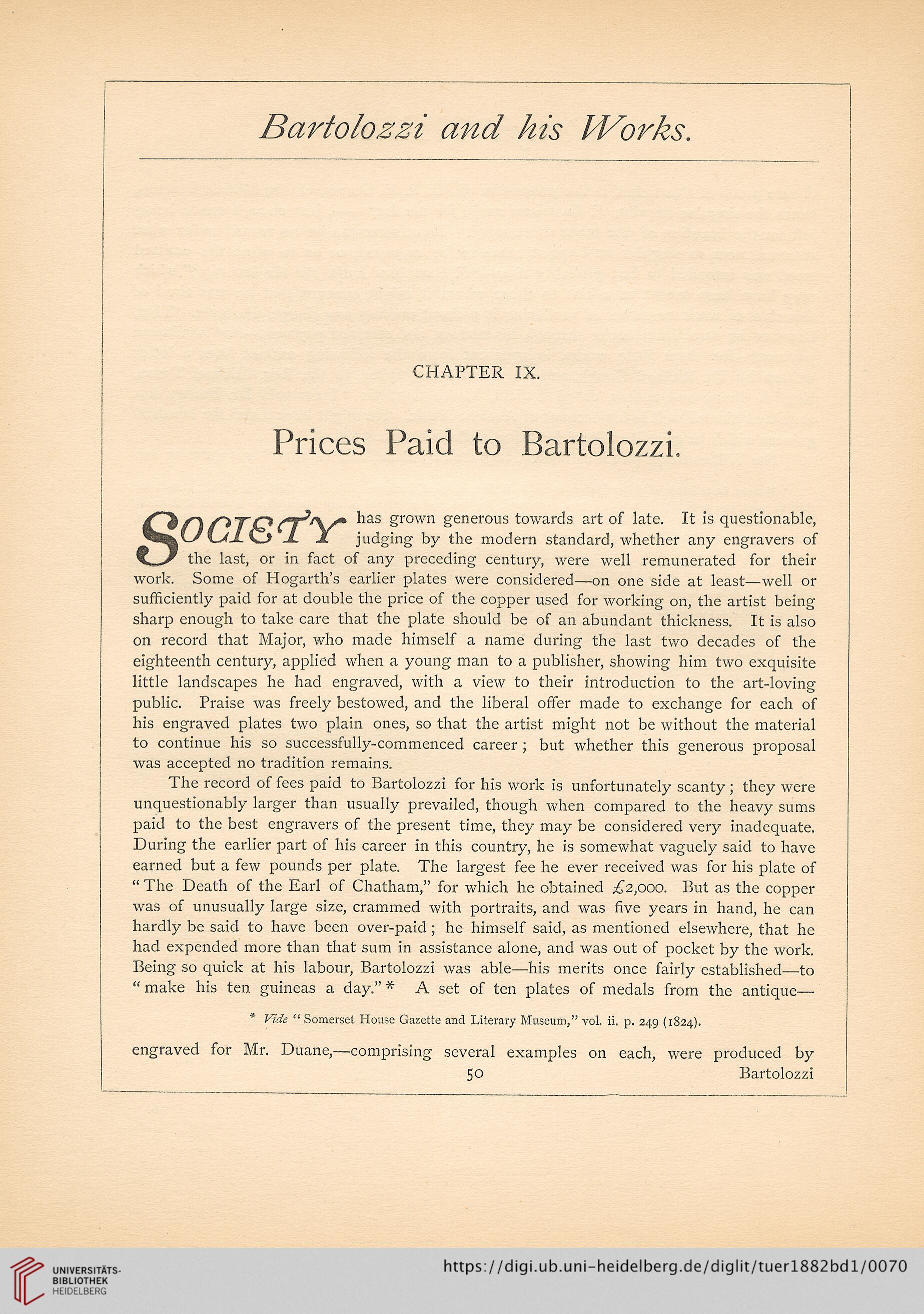Bartolo^i and his Works.
CHAPTER IX.
Prices Paid to Bartolozzi,
XT nTC? <t’/\/° has grown generous towards art of late. It is questionable,
X judging by the modern standard, whether any engravers of
( _, the last, or in fact of any preceding century, were well remunerated for their
work. Some of Hogarth's earlier plates were considered—on one side at least—well or
sufficiently paid for at double the price of the copper used for working on, the artist being
sharp enough to take care that the plate should be of an abundant thickness. It is also
on record that Major, who made himself a name during the last two decades of the
eighteenth century, applied when a young man to a publisher, showing him two exquisite
little landscapes he had engraved, with a view to their introduction to the art-loving
public. Praise was freely bestowed, and the liberal offer made to exchange for eacli of
his engraved plates two plain ones, so that the artist might not be without the material
to continue his so successfully-commenced career; but whether this generous proposal
was accepted no tradition remains.
The record of fees paid to Bartolozzi for his work is unfortunately scanty; they were
unquestionably larger than usually prevailed, though when compared to the heavy sums
paid to the best engravers of the present time, they may be considered very inadequate.
During the earlier part of his career in this country, he is somewhat vaguely said to have
earned but a few pounds per plate. The largest fee he ever received was for his plate of
"The Death of the Earl of Chatham," for which he obtained £2,000. But as the copper
was of unusually large size, crammed with portraits, and was five years in hand, he can
hardly be said to have been over-paid; he himself said, as mentioned elsewhere, that he
had expended more than that sum in assistance alone, and was out of pocket by the work.
Being so quicl< at his labour, Bartolozzi was able—his merits once fairly established—to
" make his ten guineas a day."* A set of ten plates of medals from the antique-
* Vide " Somerset House Gazette and Literary Museum," vol. ii. p. 249 (1824).
engraved for Mr. Duane,—comprising several examples on each, were
produced by
Bartolozzi
50
CHAPTER IX.
Prices Paid to Bartolozzi,
XT nTC? <t’/\/° has grown generous towards art of late. It is questionable,
X judging by the modern standard, whether any engravers of
( _, the last, or in fact of any preceding century, were well remunerated for their
work. Some of Hogarth's earlier plates were considered—on one side at least—well or
sufficiently paid for at double the price of the copper used for working on, the artist being
sharp enough to take care that the plate should be of an abundant thickness. It is also
on record that Major, who made himself a name during the last two decades of the
eighteenth century, applied when a young man to a publisher, showing him two exquisite
little landscapes he had engraved, with a view to their introduction to the art-loving
public. Praise was freely bestowed, and the liberal offer made to exchange for eacli of
his engraved plates two plain ones, so that the artist might not be without the material
to continue his so successfully-commenced career; but whether this generous proposal
was accepted no tradition remains.
The record of fees paid to Bartolozzi for his work is unfortunately scanty; they were
unquestionably larger than usually prevailed, though when compared to the heavy sums
paid to the best engravers of the present time, they may be considered very inadequate.
During the earlier part of his career in this country, he is somewhat vaguely said to have
earned but a few pounds per plate. The largest fee he ever received was for his plate of
"The Death of the Earl of Chatham," for which he obtained £2,000. But as the copper
was of unusually large size, crammed with portraits, and was five years in hand, he can
hardly be said to have been over-paid; he himself said, as mentioned elsewhere, that he
had expended more than that sum in assistance alone, and was out of pocket by the work.
Being so quicl< at his labour, Bartolozzi was able—his merits once fairly established—to
" make his ten guineas a day."* A set of ten plates of medals from the antique-
* Vide " Somerset House Gazette and Literary Museum," vol. ii. p. 249 (1824).
engraved for Mr. Duane,—comprising several examples on each, were
produced by
Bartolozzi
50




